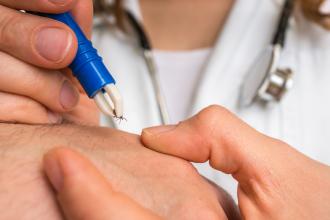Diagnostic testing for Lyme disease: Beware of false positives
Lyme disease is caused by the spirochete Borrelia burgdorferi and transmitted mainly via the tick vector Ixodes pacificus in British Columbia.[1] Polymerase chain reaction testing finds Borrelia burgdorferi in only 1 in 200 ticks, whether they are collected from the wild or submitted by patients. This frequency is fiftyfold lower than in high-incidence areas of North America.
Early Lyme disease is a clinical diagnosis based on exposure to a tick bite followed by the characteristic erythema migrans rash within 4 weeks of exposure. Later in the course of infection serological testing is used.[2] As with all other tests it is necessary to consider the validity of the test, including sensitivity and specificity.
The Centers for Disease Control and Prevention recommend a two-step process for serologic testing:[3,4] when a positive or equivocal positive using a highly sensitive enzyme immunoassay is found, it is followed by a Western blot test, which is highly specific. This method is used by major labs across North America, including the BC Public Health Microbiology and Reference Laboratory. Enzyme immunoassay alone is not very specific because antibodies to Borrelia burgdorferi proteins can cross react with common bacterial antigens,[5] leading to false positives. The BC Public Health Microbiology and Reference Laboratory uses a commercial whole-cell enzyme assay that can detect Lyme IgG and IgM simultaneously. More robust screening tests are being evaluated using the Borrelia VlsE1/pepC10 IgG/IgM ELISA to detect IgG and IgM antibodies to VlsE1 and pepC10 antigens of both European and North American strains of Borrelia burgdorferi.
Alternative laboratories have devised their own nonvalidated tests, which do not follow the two-step process. While these labs strive for high sensitivity they do not outperform reference labs in finding Lyme disease.[6] Moreover, specificity as low as 43% is reported, indicating that 57% of results coming from such labs are false positives.
In BC less than 1% of people tested for Lyme disease have the infection (personal communication with M. Morshed, 2015). Prevalence has marked ramifications for the positive predictive value and negative predictive value. Performance of the two-step method (sensitivity = 87%, specificity = 99%[5]) compared to that of an alternative laboratory (sensitivity = 70%, specificity = 43%[6]) in a population of 10 000 people with a Lyme disease prevalence of 1% is presented in the Table. Even with the reference method, positive predictive value (47%) is rather low with a low prevalence of Lyme disease. With this test the proportion of errors due to false negatives is 12%, with an overall error rate of 1%. However, when specificity is also low, as for the alternative lab,[6] positive predictive value is markedly lower (approximately 1%). The alternative lab may have a lower proportion of errors due to false negatives (0.5%), but the overall error rate is high at 57%. Improving positive predictive value in such a lab would require both a high pretest chance of Lyme disease through much more careful patient selection as well as vastly improved specificity of the test.
Advocates of alternative tests express concern about false negative results, so it must be noted that 99.5% of errors (5643 out of 5673) in alternative lab testing come from false positives and that they do not lower the false negative rate. Meanwhile, reference laboratories have vastly lower error rates and are working on ways to further improve test sensitivity.
With a high rate of false positive results and an exceedingly low positive predictive value obtained from alternative labs testing in low prevalence settings like BC, it is imperative that caution be taken when interpreting a positive result from such a source. It is suggested that Lyme disease tests be ordered from accredited labs such as the BC Public Health Microbiology and Reference Laboratory and interpreted based on the clinical likelihood of Lyme disease in the patient.
—Rakel Kling MD, MSc
—Eleni Galanis MD, FRCPC
—Muhammad Morshed, PhD, SCCM
—David M. Patrick MD, FRCP
hidden
This article is the opinion of the BC Centre for Disease Control and has not been peer reviewed by the BCMJ Editorial Board.
References
1. Morshed M, Lee M-K, Man S, et al. Surveillance for Borrelia burgdorferi in Ixodes ticks and mice in British Columbia. Presented at IDWeek 2014, Meeting of the Infectious Diseases Society of America, Philadelphia, PA, 8-12 October 2014.
2. Shapiro ED. Lyme disease. N Engl J Med 2014;370:1724-1731.
3. Centers for Disease Control and Prevention. Two-step laboratory testing process. Accessed 25 August 2015. www.cdc.gov/lyme/diagnosistesting/labtest/twostep/index.html.
4. Centers for Disease Control and Prevention (CDC). Recommendations for test performance and interpretation from the Second National Conference on Serologic Diagnosis of Lyme Disease. MMWR Morb Mortal Wkly Rep 1995;44:590-591.
5. Aguero-Rosenfeld ME, Wang G, Schwartz I, et al. Diagnosis of Lyme borreliosis. Clin Microbiol Rev 2005;18:484-509.
6. Fallon BA, Pavlicova M, Coffino SW, et al. A comparison of Lyme disease serologic test results from four laboratories in patients with persistent symptoms after antibiotic treatment. Clin Infect Dis 2014;59:1705-1710.

